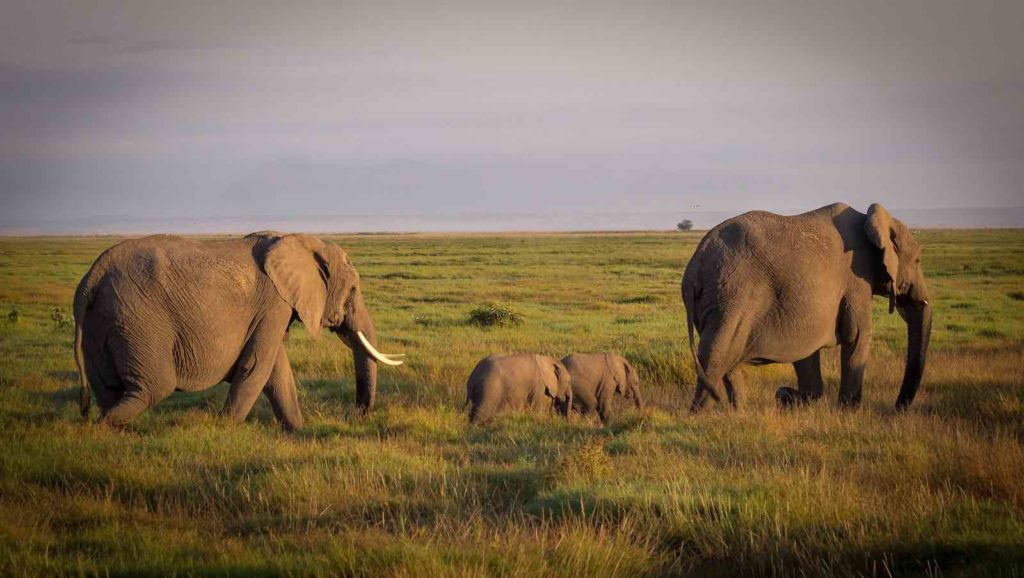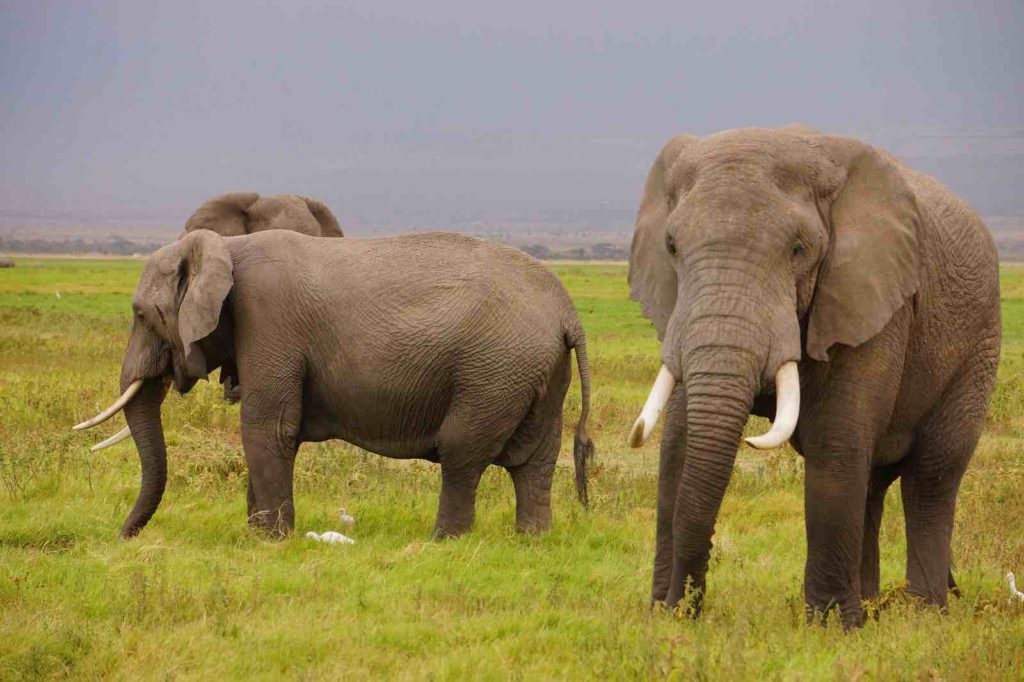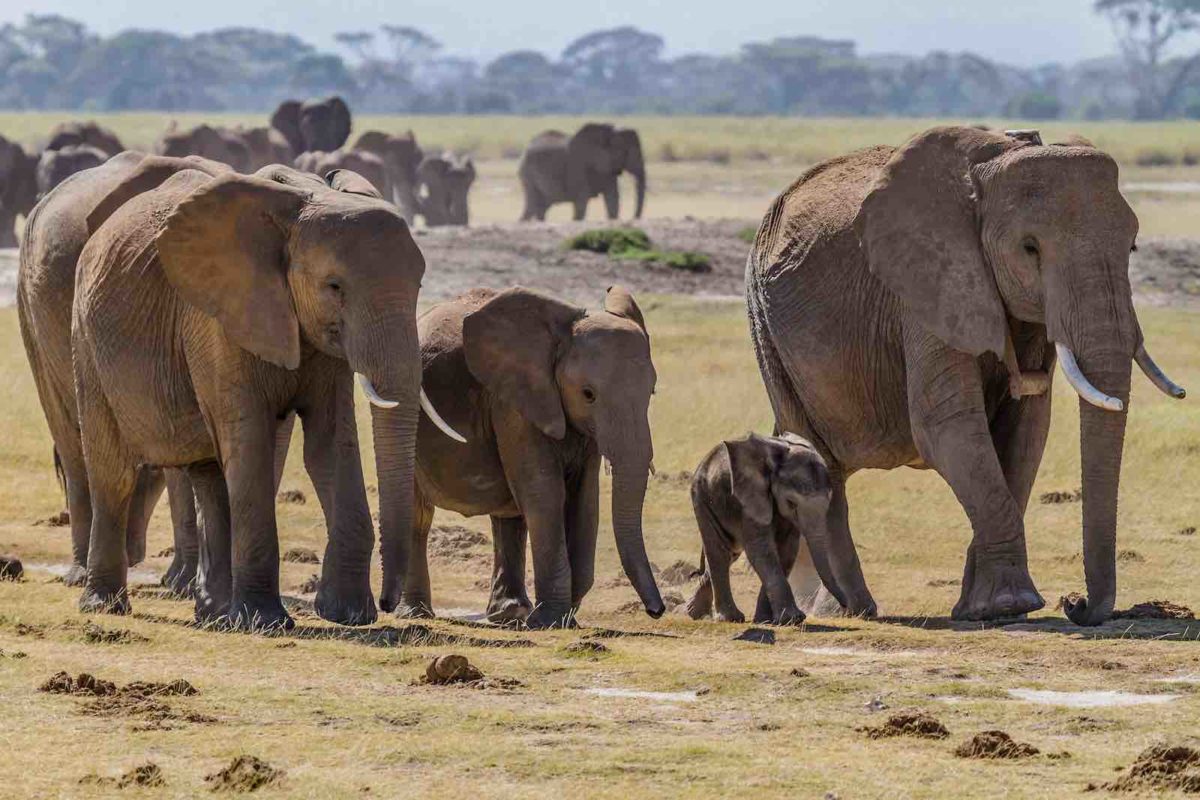Both African elephants and their Asian dito, the Asian elephant are extremely bound by history and social norms of belonging to a herd. When a baby is born, it will after a few hours take its first steps in the elephant herd.
In the herd, elephants are constantly aware of where each individual is at all times and they know which one has just had a baby and who is sick. Their an extremely loyal animal.
The elephant herd can consist of up to 100 individuals with several females and baby calves and only one older bull. The elephant herd can split into several smaller herds (or “elephant units”) if the group is too big.
Every elephant needs a herd
There are a number of reasons as to why an elephant needs to belong to a herd. The primary reasons are for shelter, safety, and to feel secure. Because elephant herds are so important for the elephants, they will choose a new herd if their old family is in danger or split up into smaller herds if there are too many individual elephants around one area.
Elephant families also seem to also need each other emotionally; when one of them dies, others may stay and mourn for a long time.
When the remaining elephant herd members finally leave, they will after a while start searching for or create another family (preferably with other elephants who knew their deceased friend).
The bachelor elephants (bulls) lead more solitary lifestyles and even if they form small groups, they do not tend to stay together for long (usually less than one year).
Elephant herds also tend to be fairly democratic groups and elephants can “vote” on many issues by using their trunks and feet. An elephant clan usually consist of:
- At least one older matriarch (the leader and decision maker) who is often the mother or grandmother of most, if not all, of the other elephants in the herd.
- Several related females and their offspring.
- Young adults between 10 and 20 years old who are still living at home with their mother and siblings (therefore often sisters and cousins).
- A few young “extra” males whom without a herd of their own or bachelor elephants.
- The older bull (and rarely other younger bulls) who is mostly wandering on his own or with other single males.
Elders are the most respected individuals in elephant society (except for the matriarch), and it is very much expected that young elephants show respect towards their elders by greeting, touching trunks, and making friendly noises to and at them.
It’s in an elephant’s DNA to respect their elderly.
The importance of the herd’s matriarch
A herd’s matriarch plays a vital role in the overall development, protection, and wellbeing of the family. The matriarch receives her position as a result of her leadership abilities, knowledge, and skills.
Her family relies on her for water in the dry season, ensuring that the young are well cared for and offer protection to other family members them when they need it most.
The matriarch is often the eldest female in a family and as such she will be the biggest and strongest of them all.
In fact, there have been studies that have shown how older African elephant females have much larger tusks than their younger relatives who are still growing, which shows that older elephants require a higher level of resources to maintain their large bodies.
The matriarch will also be the one who leads her family to all important resources, such as clean water and fresh vegetation, while also knowing where to look for foreign herds so the herd can socialize with them.
If there is ever a threat in the area (such as other predators or poachers), it’s the matriarch’s responsibility to get her family out of there.
At the same time, the rest of the elephant herd will also respect and follow their matriarchs decisions while also complying with any social rules that are required in order for them to live together as a harmonious unit.
The matriarch sets these social rules and the other elephants in her family will follow them.
It is very much a given that when it comes to elephant behavior, their herd’s matriarchs have the final say in all matters.

Raising calves together
An elephant in the wild will rarely have more than four children throughout her life. Female elephants can start to have babies when they are about 14 years old and they are pregnant for 22 months (the longest pregnancy of mammals).
The elephant herd will raise calves together as a family. The whole herd will take care of young calves as they suckle them, play with them and protect them from any danger.
They also teach the little ones how to use their trunks, terms that others in the family understand and learn to communicate with each other.
Calves learn a lot from their elders and watch them closely (and often copy) as the adults go about their daily business.
The other females in a family will also adopt any orphaned calves as if they were their own children, suckling them and raising them alongside their biological young until such time that these adopted calves are strong enough to stand on their own two feet (or four).
Alloparenting where a calf is cared for by someone other than its mother – takes place in some family groups. Allomothers are typically two to twelve years old. Adoption of calves is rare but does occur, especially in the case of an orphaned calf.
Females with their calves
When it comes to baby elephants, many people tend to only see the mothers and young. However, they don’t always know that other female elephants will also play a very important role when it comes to the young’s upbringing.
In fact, other female elephants will play a vital role as they also help look after the young. In particular, older sisters and close relatives to the mother of a baby elephant will help care for them – including mothers who have lost their own calves.
The reason why this type of behavior takes place is because of the strong family bond that elephants share with each other.
They know that it takes a whole herd to care for their young and they will do their utmost to ensure that everyone does what is required in order to protect, teach and raise young calves as best they can.
Elephant bull dynamics
It is often believed that male elephants are aggressive creatures, but the truth of the matter is that bull elephants actually have a very calming impact on their herd.
When male elephants enter into adulthood (normally the bulls leave the herd when they are 13 years old), they are forced to leave their family in order to live solitary lives, which allows them to spread their seed far and wide.
Even so, bulls will return from time to time in order to visit their family and make sure they are all okay. They will also bring with them fresh vegetation and water – as well as playing and socializing with the other young bulls within the elephant herd.
Bull elephants will also form strong relationships with older bulls – especially those who live outside of a breeding unit – but will also work together with the rest of the family.
If there are problems, it is often one or two of these bulls that will lead them away from danger and take the time to protect the other members.
It’s common for bull elephants to form strong friendships with each other which can last for their entire lives. But they can also be quite aggressive with other elephants.
They know they need each other and will remain close no matter what. There are even cases where males have shown signs of depression after losing their closest friend.
Is there a difference between elephant population structures in Africa and Asia?
In the case of elephants in Amboseli National Park, Kenya, a female’s life is full with interaction with other families, clans, and subpopulations. Families may connect and bond with one another, forming what are known as bond groups that contain typically two family groups that are loyal to each other during the dry season.
There are typically nine groups in a clan. The Amboseli elephant population is further divided into the “central” and “peripheral” subpopulations.
Some elephant populations in India and Sri Lanka have similar basic social organisations. There appear to be cohesive family units and loose aggregations. They have been observed to have “nursing units” and “juvenile-care units”.
In southern India, elephant populations may contain family groups, bond groups and possibly clans.
Family groups tend to be small, consisting of one or two adult females and their offspring. A group containing more than two adult females plus offspring is known as a “joint family”.
Malay elephant populations have even smaller family units and do not have any social organisation higher than a family or bond group. Groups of African forest elephants typically consist of one adult female with one to three offspring.
These groups appear to interact with each other, especially at forest clearings.
(This section is researched from Wikipedia, there’s a reference to Sukumar, pp. 175–79)

Summary
Elephant herds are close-knit units that share a strong family bond. Female elephants, both young and old, take care of calves together and play an important role in their upbringing.
Male elephants, once they reach adulthood, are forced to leave their family but often return to visit and check up on them. Bulls have a calming influence on the herd and work together to protect them from danger.
The way elephant families work together is truly unique and it just goes to show the strength they feel for one another, as well as how important family really is.
This type of behavior is not seen in many different species – one that should be treasured and protected.
FAQ about Elephant herds
It’s called a “herd”. But sometimes they’re also referred to as population, clan, or family.
Yes, elephants live in herds.
There can be anywhere from 20 to 100 elephants in a herd.
Female elephants do live with the males. The males are not part of the herd and will leave once they reach adulthood.
Yes, elephants do have a leader. This is the oldest female in the herd, known as a matriarch.
Elephants live in a herd for protection and to make it easier to care for the young.
Yes, elephant herds are matriarchal. All the elephants in the herd take orders from the oldest female.
Elephants walk in a line because it is safer and they believe that the matriarch (the female leader) knows where to go.
An elephant herd is like a big family. They all take care of each other and protect the young ones.

5 replies on “Elephant herd and social behavior”
[…] they always walked in a line “because it is safer and they believe that the matriarch (the female leader) knows where to […]
Enjoyed reading this and amazing pictures ! I plan to read this article to my students .
Thank you for your kind words Preetha. Have a great day!
[…] Sumber Gambar: https://elephantguide.com/en/facts-about-elephant-herd/ […]
Gracias por el artículo. Vi hace un tiempo un documental en el que una cría perdía a su madre y la matriarca obligaba a una tía a darle de mamar. La tía no quería ya que tenía su propia cría. Al final, salían las dos adelante. Pero no recuerdo cómo se llamaba el documental.